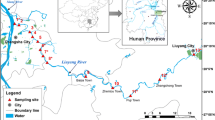Abstract
In order to investigate the relationship between the trace elements and the characteristics of the oysters, we analyzed the trace elements present in the germplasm of oysters from different producing areas in the Jiaozhou Bay. The element fingerprints were established to reflect the elemental characteristics of the oysters. Concentration patterns of the elements were deciphered by principle component analysis (PCA) and hierarchical cluster analysis (HCA). The six regions were discriminated with accuracy using HCA and PCA based on the concentration of 16 trace elements. The elements were viewed as characteristic elements of the oysters and the fingerprints of these elements could be used to distinguish the quality of the oysters.
Similar content being viewed by others
References
Chen, Q. L., Yao, C., and Ouyang, P. K., 2005. Determination of constant and trace elements in Ranunculus Ternatus Thunb by ICP-OES. Spectroscopy and Spectral Analysis, 25: 560–564.
Chen, Y. X., Yu, M. G., and Xu, J., 2009. Differentiation of eight tea (Camellia sinensis) cultivars in China by elemental fingerprint of their leaves, Journal of the Science of Food and Agriculture, 89: 2350–2355.
Ernst, E., 2002. Toxic heavy metals and undeclared drugs in Asian herbal medicines. Trends in Pharmacological Sciences, 23: 136–139.
Flower, A., Lewith, G., and Little, P., 2011. Combining rigour with relevance: A novel methodology for testing Chinese herbal medicine. Journal of Ethnopharmacology, 134: 373–378.
Jolliffe, I., 2004. Principal Component Analysis. Springer, New York, 150–165.
Kang, H. N., Yang, M. F, and Chen, B., 2006. Trace element determination in teas and discrimination analysis for teas. Rock and Mineral Analysis, 25(1): 22–26.
Lin, H. M., and Zhang, W. L., 2005, The similarities and differences between Principal Component Analysis and Factor Analysis of SPSS software. Statistical Research, 3: 65–69.
Marengo, E., and Aceto, M., 2003, Statistical investigation of the differences in the distribution of metals in Nebbiolo-based wines. Food Chemistry, 81: 621–630.
Razmovski-Naumovski, V., Tongkao-on, W., and Kimble, B., 2010, Multiple chromatographic and chemometric methods for quality standardisation of Chinese herbal medicines. Modern Traditinal Chinese Medicine Material, 12(1): 99–106.
Szentmihalyi, K., Csiktusnadi-Kiss G. A., and Keszler A., 2000, Method development for measurement of elements in Hungarian red wines by inductively coupled plasma optical emission spectrometry (ICP-OES). Acta Aliment, 29: 105–121.
Varmuza, K, and Filzmoser, P., 2009, Introduction to Multivariate Statistical Analysis in Chemometrics. CRC Press, Boca Raton, 36–37.
Wang, Q., Mu, S. M., Cao, G., Liu, G. R., Ma, D. D., and Kang, X. J., 2006. Gel electrophoresis of lactate dehydrogenase (LDH) in different tissues of Eriocheir sinensis. Marine Sciences, 30(4): 31–96 (in Chinese with English abstract).
Xu, L, and Shao, X. G., 2006, Chemometric Methods. Science Press, Bei**g, 67–85 (in Chinese with English abstract).
Yang, M. H., and Wang, L. N. 2008, Advances in techniques on analysis and removal of pesticide residues in traditional Chinese herbal medicines. Modern Traditinal Chinese Medicine Material, 10(1): 107–112.
Yan, L. N., Cheng, B., and Yao, S. Z., 2008, Study on element fingerprint of Chinese traditional herb by ICP-MS and AAS. Asia-Pacific Traditional Medicine, 4: 26–29.
Ye, S. S. Yang, J., Liu, H. B., and Oshima, Y., 2011, Use of elemental fingerprint analysis to identify localities of collection for the large icefish protosalanx chinensis in Taihu Lake, China. Journal of the Faculty of Agriculture Kyushu, 56(1): 41–45.
Zheng, K., and Yan, C. W., 2011, Application of ICP-AES with microwave digestion to detect trace elements in oysters from Jiaozhou Bay, China. Journal of Ocean University of China (Oceanic and Coastal Sea Research), 10(3): 301–304.
Author information
Authors and Affiliations
Corresponding author
Rights and permissions
About this article
Cite this article
Zheng, Y., Zheng, K. & Li, Y. Study on elemental fingerprint of traditional marine Chinese medicine oysters from Jiaozhou Bay, China. J. Ocean Univ. China 11, 397–400 (2012). https://doi.org/10.1007/s11802-012-1917-7
Received:
Revised:
Accepted:
Published:
Issue Date:
DOI: https://doi.org/10.1007/s11802-012-1917-7




